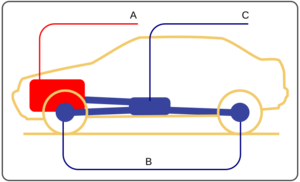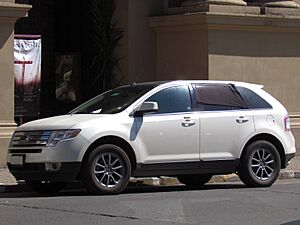Four-wheel drive facts for kids

A Four-wheel drive (often called 4WD or 4x4) is a type of vehicle where all four wheels get power from the engine. This helps the vehicle move forward. In a regular car, usually only two wheels get power. 4WD vehicles are often used for driving off road, like on dirt paths, rocks, or through mud.
Many 4WD vehicles have a special part called a transfer case. This part helps send power from the engine to either two wheels or all four wheels. It's like a special gear system. Some transfer cases also have a "low gear" setting. This setting makes the engine's power much stronger, which is useful for climbing steep hills or getting unstuck.
Contents
Types of 4WD Systems

"A" points at the engine, "B" points at a driving wheel, "C" points at the transfer case or center differential depending on system
There are a few main types of four-wheel drive systems. Each type works a bit differently and is best for different driving situations.
Part-time 4-wheel drive
Part-time 4WD systems are the most common type, especially for vehicles used off-road. You can switch these systems between two-wheel drive (2WD) and four-wheel drive (4WD). This means you can drive normally on paved roads in 2WD and then switch to 4WD when you go off-road.
When you use 4WD in a part-time system, all four wheels turn at the exact same speed. Because of this, you should not use part-time 4WD on dry, paved roads. Doing so can damage your tires and the car's parts. These vehicles usually sit higher off the ground. This helps them drive over obstacles like rocks or bumps without getting damaged. Even when driven in 2WD on regular roads, these cars usually use more fuel than a similar two-wheel drive vehicle. Some models have "locking hubs" which can disconnect the front wheels to save a little fuel when driving in 2WD.
Full-time 4-wheel drive
Full-time 4WD systems were designed for serious off-road driving. These vehicles always send power to all four wheels. They often have special parts called "locking differentials." These parts help make sure that if one wheel loses grip, the other wheels on the same axle still get power and can keep moving.
Because these vehicles are built tough and are often heavier, they usually don't get very good gas mileage.
All-Wheel Drive
All-wheel drive (AWD) systems are different from traditional 4WD. They use a special part called a "center differential" to send power to both the front and rear wheels. The amount of power sent to each axle can change depending on how much grip each wheel has.
AWD is not usually designed for extreme off-road driving. Instead, it's made to help you get better grip on regular roads, especially when it's raining, snowing, or icy. Many crossover vehicles, which are built more like cars than trucks, use AWD. However, some larger vehicles like the Jeep Grand Cherokee and Dodge Durango can also have full-time 4WD systems.
Part-Time All-Wheel Drive
Part-time All-wheel drive (AWD) systems usually work like a front-wheel drive car under normal conditions. This means only the front wheels get power. If the system senses that the front wheels are losing grip, it automatically sends some power to the rear wheels to help the car move.
As soon as the car gets good grip again, the system stops sending power to the rear wheels and goes back to front-wheel drive. This type of system is often found in smaller cars because it's less expensive and doesn't add much weight. It also usually gets better fuel economy than full-time AWD vehicles. These systems do not have a "low range" gear or a transfer case like traditional 4WD vehicles.
Images for kids
-
The Jeep Wrangler (pictured is a TJ Wrangler) is a 4WD vehicle with a transfer case to select low-range or high-range four-wheel drive.
-
The Lamborghini Murciélago is an AWD that powers the front via a viscous coupling unit if the rear slips
-
The HMMWV is a 4WD/AWD that powers all wheels evenly (continuously) via a manually lockable center differential, with Torsen differentials for both front and rear
See also
 In Spanish: Tracción en las cuatro ruedas para niños
In Spanish: Tracción en las cuatro ruedas para niños
























